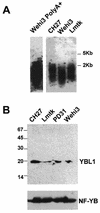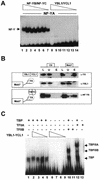Cloning and characterization of the histone-fold proteins YBL1 and YCL1
- PMID: 11000277
- PMCID: PMC110757
- DOI: 10.1093/nar/28.19.3830
Cloning and characterization of the histone-fold proteins YBL1 and YCL1
Abstract
Histones are among the most conserved proteins in evolution, sharing a histone fold motif. A number of additional histonic proteins exist and are involved in the process of transcriptional regulation. We describe here the identification, cloning and characterization of two small members of the H2A-H2B sub-family (YBL1 and YCL1) related to the NF-YB and NF-YC subunits of the CCAAT-binding activator NF-Y and to the TATA-binding protein (TBP) binding repressor NC2. Unlike the latters, YBL1 and YCL1 have no intrinsic CCAAT or TATA-binding capacity. In nucleosome reconstitution assays, they can form complexes with histones in solution and on DNA and they are part of relatively large complexes, as determined by glycerol gradient experiments. Our data support the idea that YBL1 and YCL1 are divergent with respect to NF-YB and NF-YC for specific functions, but have coevolved the capacity to interact with nucleosomal structures.
Figures







Similar articles
-
CCAAT binding NF-Y-TBP interactions: NF-YB and NF-YC require short domains adjacent to their histone fold motifs for association with TBP basic residues.Nucleic Acids Res. 1997 Jun 1;25(11):2174-81. doi: 10.1093/nar/25.11.2174. Nucleic Acids Res. 1997. PMID: 9153318 Free PMC article.
-
NF-Y histone fold alpha1 helices help impart CCAAT specificity.J Mol Biol. 1999 Feb 19;286(2):327-37. doi: 10.1006/jmbi.1998.2496. J Mol Biol. 1999. PMID: 9973554
-
NF-Y associates with H3-H4 tetramers and octamers by multiple mechanisms.Mol Cell Biol. 1999 Dec;19(12):8591-603. doi: 10.1128/MCB.19.12.8591. Mol Cell Biol. 1999. PMID: 10567583 Free PMC article.
-
The nucleosome: a powerful regulator of transcription.Prog Nucleic Acid Res Mol Biol. 1998;61:379-422. doi: 10.1016/s0079-6603(08)60832-6. Prog Nucleic Acid Res Mol Biol. 1998. PMID: 9752726 Review.
-
Structural determinants for NF-Y/DNA interaction at the CCAAT box.Biochim Biophys Acta Gene Regul Mech. 2017 May;1860(5):571-580. doi: 10.1016/j.bbagrm.2016.09.006. Epub 2016 Sep 25. Biochim Biophys Acta Gene Regul Mech. 2017. PMID: 27677949 Review.
Cited by
-
Coordinated regulation of heterochromatin inheritance by Dpb3-Dpb4 complex.Proc Natl Acad Sci U S A. 2017 Nov 21;114(47):12524-12529. doi: 10.1073/pnas.1712961114. Epub 2017 Nov 6. Proc Natl Acad Sci U S A. 2017. PMID: 29109278 Free PMC article.
-
Subunits of the heterotrimeric transcription factor NF-Y are imported into the nucleus by distinct pathways involving importin beta and importin 13.Mol Cell Biol. 2005 Jul;25(13):5339-54. doi: 10.1128/MCB.25.13.5339-5354.2005. Mol Cell Biol. 2005. PMID: 15964792 Free PMC article.
-
Characterization of LEAFY COTYLEDON1-LIKE gene in Helianthus annuus and its relationship with zygotic and somatic embryogenesis.Dev Genes Evol. 2006 May;216(5):253-64. doi: 10.1007/s00427-005-0050-7. Epub 2006 Feb 1. Dev Genes Evol. 2006. PMID: 16450129
-
Characterization of leafy cotyledon1-like during embryogenesis in Theobroma cacao L.Planta. 2008 Mar;227(4):853-66. doi: 10.1007/s00425-007-0662-4. Epub 2007 Dec 18. Planta. 2008. PMID: 18094994
-
Arabidopsis LEAFY COTYLEDON1 represents a functionally specialized subunit of the CCAAT binding transcription factor.Proc Natl Acad Sci U S A. 2003 Feb 18;100(4):2152-6. doi: 10.1073/pnas.0437909100. Epub 2003 Feb 10. Proc Natl Acad Sci U S A. 2003. PMID: 12578989 Free PMC article.
References
-
- Workman J.L. and Kingston,R.E. (1998) Annu. Rev. Biochem., 67, 745–779. - PubMed
-
- Strahl B.D. and Allis,C.D. (2000) Nature, 403, 41–45. - PubMed
-
- Luger K., Mader,A.W., Richmond,R.K., Sargent,D.F. and Richmond,T.J. (1997) Nature, 389, 251–260. - PubMed
-
- Starich M.R., Sandman,K., Reeve,J.N. and Summers,M.F. (1996) J. Mol. Biol., 255, 187–203. - PubMed
Publication types
MeSH terms
Substances
Associated data
- Actions
- Actions
LinkOut - more resources
Full Text Sources
Molecular Biology Databases

